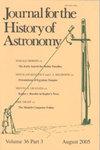More ancient Greek sundials
IF 0.3
3区 哲学
Q3 HISTORY & PHILOSOPHY OF SCIENCE
引用次数: 0
Abstract
31 sites in the Cuzco region of the following horizon event(s): calculated azimuth to solar rising/setting event (i.e. solstice or equinox), measured azimuth, magnetic declination, corrected azimuth, and measured inclination. To put his astronomical data in historical and cultural contexts, Gullberg begins with an overview of Inca history (Chapter 2), followed by a broad and fairly general discussion of some of the major elements of Inca culture (Chapter 3). Chapter 4 is an introduction to the system for the organization of social, political, and ritual life in the Inca capital, known as the “ceque system.” This is followed, in Chapter 5, by a sort of “user’s guide” to archaeoastronomical field techniques and a brief overview of past archaeoastronomical studies in the Cuzco region. Chapter 6 is a summary/overview of Inca astronomy and cosmology, including discussions of Inca solar worship, festivals, the calendar, and what is known about Inca interest in and knowledge of the Moon, Milky Way, and their constellations. These introductory chapters are followed by Gullberg and his team’s measurements and findings at sites near to Cuzco (Chapter 7), within the so-called “sacred valley” to the east of Cuzco (Chapter 8), and orientations of sites and structures in and around Machu Picchu (Chapter 9). The book ends with a discussion of his findings and conclusions (Chapter 10). The book is astonishingly well illustrated, with a total of 312 figures (an average of almost one figure/page!). The illustrations include both black-and-white and color photographs of archaeological sites and other items of cultural interest, as well as many original pencil drawings and watercolor paintings of sites and cultural miscellanea by the author’s spouse, Jessica Gullberg. In sum, this is a highly informed and informative book. It raises the standard of the study of Inca astronomy and archaeoastronomy to a whole new level.更多古希腊日晷
以下地平线事件在库斯科地区的31个地点:计算的太阳升起/落下事件的方位角(即至点或分点)、测量的方位角、磁偏角、校正的方位角和测量的倾角。为了将他的天文数据放在历史和文化背景下,Gullberg首先概述了印加历史(第2章),然后对印加文化的一些主要元素进行了广泛而一般的讨论(第3章)。第4章介绍了印加首都社会、政治和仪式生活的组织系统,称为“ceque系统”。第5章介绍了考古天文学领域技术的“用户指南”,并简要概述了库斯科地区过去的考古天文学研究。第6章是印加天文学和宇宙学的总结/概述,包括对印加太阳崇拜、节日、日历的讨论,以及印加人对月球、银河系及其星座的兴趣和知识。在这些介绍性章节之后,Gullberg和他的团队对库斯科附近、库斯科以东所谓的“神圣山谷”内的遗址进行了测量和发现(第7章),并对马丘比丘及其周围的遗址和结构进行了定位(第9章)。本书最后讨论了他的发现和结论(第10章)。这本书的插图非常好,共有312个数字(平均每页几乎一个数字!)。插图包括考古遗址的黑白和彩色照片以及其他具有文化意义的物品,以及许多遗址的原始铅笔画和水彩画,以及作者配偶Jessica Gullberg的文化杂录。总之,这是一本见多识广、内容丰富的书。它将印加天文学和古天文学的研究标准提高到了一个全新的水平。
本文章由计算机程序翻译,如有差异,请以英文原文为准。
求助全文
约1分钟内获得全文
求助全文
来源期刊

Journal for the History of Astronomy
地学天文-科学史与科学哲学
CiteScore
0.50
自引率
25.00%
发文量
44
审稿时长
>12 weeks
期刊介绍:
Science History Publications Ltd is an academic publishing company established in 1971 and based in Cambridge, England. We specialize in journals in history of science and in particular history of astronomy.
 求助内容:
求助内容: 应助结果提醒方式:
应助结果提醒方式:


